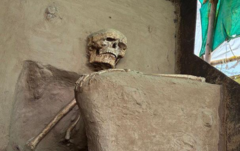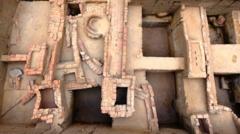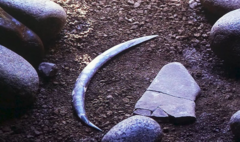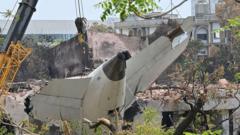Six years after its unearthing, a historically significant skeleton remains in a makeshift tent, with officials still disputing its rightful ownership, leaving it vulnerable and unprotected.
Bureaucratic Delays Leave Ancient Indian Skeleton in Limbo

Bureaucratic Delays Leave Ancient Indian Skeleton in Limbo
A 1,000-year-old skeleton, discovered in Gujarat, awaits its rightful home amid red tape.
An ancient skeleton, believed to be over 1,000 years old, is in limbo in Vadnagar, Gujarat, as bureaucratic complications thwart its movement to a suitable museum six years post-discovery. Unearthed in 2019 by archaeologist Abhijit Ambekar during an excavation, the remarkable find was discovered sitting cross-legged, representing a rare burial posture similar to that found at only three other sites in India.
The skeleton, likely from the Solanki dynasty period (940 to 1300 CE), provides invaluable insights into ancient Indian lifestyles and customs. Ambekar argues its significance transcends local interest, reflecting a broader cultural heritage of the country. However, instead of being housed properly, the skeleton remains in a makeshift shelter, without robust protection or security. Complications arise from disputes between the Archaeological Survey of India (ASI) and regional authorities over ownership. Currently, the Gujarat government contends that the skeleton hasn't been officially transferred to local museums, hindering its proper housing.
Despite excavations leading to the retrieval of around 9,000 artifacts, including the skeleton, the ASI has stated that the skeleton is still with them. The local government has reassured that steps are continually being taken to relocate it to a museum but has yet to provide a timeline. Local residents and historians express frustration at the neglect shown to such a significant archaeological treasure, arguing that a historical artifact of this nature should not be left unguarded and exposed to the elements.
The skeleton’s notable features—its position and the remarkable preservation of its remains—point to a unique burial custom. Ambekar believes a thorough analysis of its ancestry could provide further clarity on ancient regional diets and practices. Local citizens are advocates for the skeleton's proper exhibition, believing it would attract tourists and showcase Vadnagar’s rich cultural history.
While a modern Archaeological Experiential Museum has been established nearby, showcasing a vast array of artifacts, the absence of the skeleton inside is notable. Local history enthusiasts, like resident Jesang Thakor, are voicing their disappointment with delay and insufficient action, insisting that Vadnagar's 1,000-year-old treasure deserves more than a plastic-covered existence. Advocates for the skeleton's proper handling are hopeful for timely resolution, anticipating a future where this embodiment of ancient heritage receives the respect and attention it rightfully merits.





















